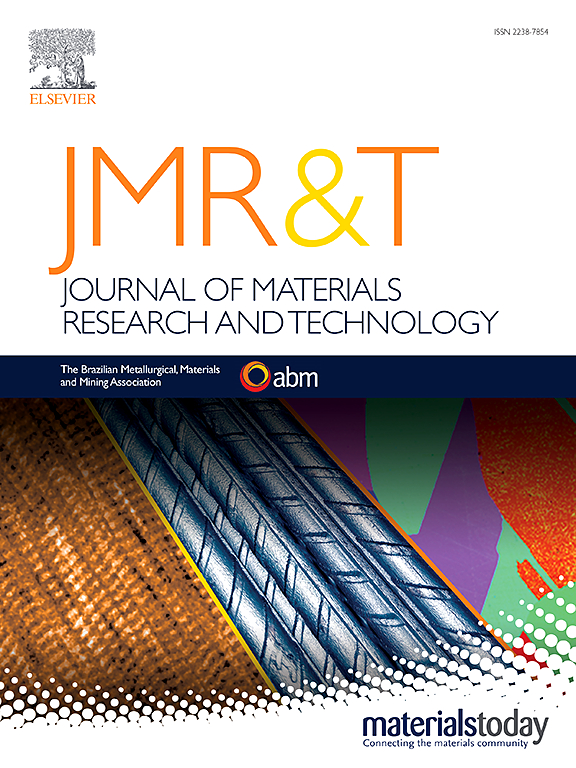Characterization of Ti–48Al–2Cr–2Nb fabricated by directed energy deposition
IF 6.6
2区 材料科学
Q1 MATERIALS SCIENCE, MULTIDISCIPLINARY
Journal of Materials Research and Technology-Jmr&t
Pub Date : 2025-06-09
DOI:10.1016/j.jmrt.2025.06.050
引用次数: 0
Abstract
The additive manufacturing process known as directed energy deposition (DED) is an effective method for repairing parts in aerospace and other industries. In this study, a DED system equipped with a heating component and an inert gas shield system to mitigate the effects of cracks and oxidation was applied for the deposition of Ti–48Al–2Cr–2Nb (at.%), a gamma titanium aluminide used in turbine blades for commercial engines. The microstructure obtained from the proposed DED process was dominated by the γ phase (area ratio of 99.38 %) with a small grain size (mean diameter of 7.4 μm) as a result of massive transformation. A γ/γ lamellar structure was also identified. Massive transformation was induced because the DED met certain conditions, such as a high cooling rate, high Al content (above 49 at.%), and a fine microstructure attributed to the powders. The microstructure obtained by DED contributed to excellent mechanical properties, including a tensile strength of 471 MPa at 750 °C and a creep life of 357 h at 750 °C/200 MPa, which are even superior to those of conventional HIPed TiAl casting materials. The EBSD and TEM analyses suggested that the hybrid microstructure consisting of lamellae separated by high-angle grain boundaries with random orientation and lamellae separated by low-angle grain boundaries within a γ grain, combined with fine γ/γ lamellar spacing of 253 nm, would act as a barrier to dislocation shear. This microstructure is distinct from the widely observed α2/γ lamellar grain with semi-coherent boundaries that follow the Blackburn orientation relationship. Finally, our experiments indicate that powder DED, when well managed with heating and an inert gas system, is a potential method for repairing parts.

定向能沉积制备Ti-48Al-2Cr-2Nb的表征
被称为定向能沉积(DED)的增材制造工艺是航空航天和其他行业修复零件的有效方法。在这项研究中,采用了一个配备加热组件和惰性气体保护系统的DED系统,以减轻裂纹和氧化的影响,用于沉积Ti-48Al-2Cr-2Nb (at.%), Ti-48Al-2Cr-2Nb是一种用于商用发动机涡轮叶片的γ钛铝化物。在此过程中得到的组织以γ相为主(面积比为99.38%),晶粒尺寸较小(平均直径为7.4 μm)。还鉴定出γ/γ片层结构。由于DED满足一定的条件,如高冷却速度、高Al含量(大于49at .%)和粉末的细组织,导致了大量的转变。通过DED获得的微观组织有助于获得优异的力学性能,包括750°C时的抗拉强度为471 MPa, 750°C/200 MPa时的蠕变寿命为357 h,甚至优于传统HIPed TiAl铸造材料。EBSD和TEM分析表明,由随机取向的高角度晶界片层和低角度晶界片层组成的杂化微观结构,结合253 nm的细小γ/γ片层间距,可以起到位错剪切的屏障作用。这种微观结构不同于广泛观察到的α2/γ片层晶粒,具有遵循Blackburn取向关系的半共格边界。最后,我们的实验表明,在加热和惰性气体系统的良好管理下,粉末DED是一种潜在的修复零件的方法。
本文章由计算机程序翻译,如有差异,请以英文原文为准。
求助全文
约1分钟内获得全文
求助全文
来源期刊

Journal of Materials Research and Technology-Jmr&t
Materials Science-Metals and Alloys
CiteScore
8.80
自引率
9.40%
发文量
1877
审稿时长
35 days
期刊介绍:
The Journal of Materials Research and Technology is a publication of ABM - Brazilian Metallurgical, Materials and Mining Association - and publishes four issues per year also with a free version online (www.jmrt.com.br). The journal provides an international medium for the publication of theoretical and experimental studies related to Metallurgy, Materials and Minerals research and technology. Appropriate submissions to the Journal of Materials Research and Technology should include scientific and/or engineering factors which affect processes and products in the Metallurgy, Materials and Mining areas.
 求助内容:
求助内容: 应助结果提醒方式:
应助结果提醒方式:


